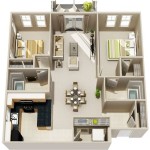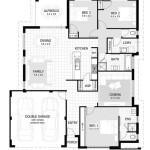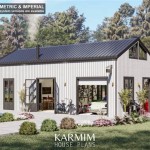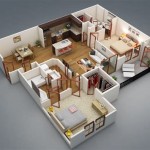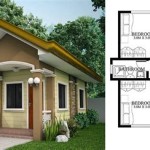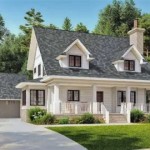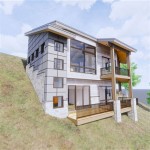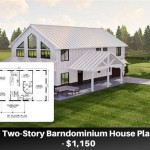1 Bedroom A-Frame House Plans: A Comprehensive Guide
The A-frame house, characterized by its steeply angled roof that doubles as its walls, has experienced enduring popularity for its efficiency, aesthetic appeal, and relatively simple construction. While often associated with larger vacation homes, the 1-bedroom A-frame presents a compelling option for individuals or couples seeking a compact, modern, and potentially cost-effective dwelling. This article explores the nuances of 1-bedroom A-frame house plans, highlighting key considerations for design, functionality, and construction.
The inherent design of the A-frame offers several advantages. The sloped roof sheds snow and rain efficiently, making it suitable for various climates. The simplified structure typically results in lower construction costs compared to conventional rectangular homes. Furthermore, the dramatic roofline creates a unique architectural statement, often blending seamlessly with natural surroundings, especially in wooded or mountainous locations.
However, prospective homeowners must also acknowledge the potential drawbacks. The sloping walls can limit usable floor space, particularly on upper levels. Careful space planning is crucial to maximize functionality and prevent a cramped feeling. Optimizing storage solutions and utilizing vertical space becomes paramount in a 1-bedroom A-frame design.
Key Point 1: Design Considerations for 1-Bedroom A-Frame Plans
Designing a functional and comfortable 1-bedroom A-frame requires meticulous planning. The triangular shape presents unique challenges and opportunities that demand creative solutions. Several key factors influence the overall design and livability of the space.
Floor Plan Layout: The floor plan is the foundation of any successful house design. In a 1-bedroom A-frame, the layout often involves a single open-concept living space on the ground floor, incorporating the kitchen, dining area, and living room. The bedroom is typically located on a lofted upper level, accessible by stairs or a ladder. Alternatively, the bedroom can be situated on the ground floor, sacrificing some living space but potentially offering greater accessibility and privacy.
Careful consideration must be given to the placement of windows and doors to maximize natural light and ventilation. Large windows on the front and rear facades can illuminate the interior and provide panoramic views. Strategically placed skylights can brighten the upper level and enhance the feeling of spaciousness. The positioning of doors should optimize traffic flow and ensure easy access to outdoor areas.
Space Optimization: Maximizing usable space is critical in a compact A-frame design. Built-in storage solutions, such as shelves and cabinets integrated into the walls, can help minimize clutter and maximize floor area. Multi-functional furniture, such as a sofa bed or a dining table that can be folded away, can provide flexibility and adaptability. Vertical space should be fully utilized, with shelves extending to the ceiling and lofted areas providing additional storage options.
Loft Design and Accessibility: The loft area, typically housing the bedroom, presents both challenges and opportunities. The sloping roofline can restrict headroom, particularly near the edges of the loft. Careful planning is required to ensure sufficient headroom for comfortable movement and sleeping. The choice of staircase or ladder greatly impacts the accessibility of the loft. Stairs offer greater stability and ease of use, but require more floor space. Ladders are more space-efficient but may not be suitable for individuals with mobility limitations.
Bathroom Placement and Design: The bathroom is typically located on the ground floor. Compact bathroom fixtures and space-saving layouts are essential. A shower stall is often preferred over a bathtub to conserve space. Wall-mounted sinks and toilets can further enhance the feeling of spaciousness. Adequate ventilation is crucial to prevent moisture buildup and maintain air quality.
Kitchen Design: The kitchen is often integrated into the open-concept living space. A galley kitchen or a compact L-shaped kitchen layout is often the most efficient use of space in an A-frame. Using vertical space for storage, with tall cabinets and shelves, is essential. Selecting appliances with compact dimensions is also important. A breakfast bar or a small island can provide additional counter space and seating.
Key Point 2: Functionality and Practicality of 1-Bedroom A-Frame Homes
Beyond aesthetics, the functionality and practicality of a 1-bedroom A-frame are paramount for comfortable living. Several factors contribute to the overall usability and livability of the space.
Insulation and Energy Efficiency: Due to the large surface area of the roof, proper insulation is crucial for energy efficiency and thermal comfort. High-quality insulation materials should be used throughout the structure, including the roof, walls, and floor. Adequate ventilation is also important to prevent moisture buildup and maintain air quality. Consider incorporating energy-efficient windows and doors to minimize heat loss. The orientation of the A-frame can also impact energy efficiency. Orienting the house with the long sides facing south can maximize solar gain in the winter and reduce heating costs.
Heating and Cooling Systems: The choice of heating and cooling systems depends on the climate and the size of the A-frame. A mini-split system, which consists of an outdoor compressor and one or more indoor air handlers, is a popular option for A-frame homes. These systems are energy-efficient and can provide targeted heating and cooling to specific areas. A wood-burning stove can also provide an efficient and aesthetically pleasing source of heat. For cooling, ceiling fans can circulate air and enhance the effectiveness of air conditioning systems.
Storage Solutions: As previously mentioned, storage is a critical consideration in a compact A-frame. Built-in storage solutions are essential for maximizing usable space and minimizing clutter. Under-stair storage can be used to store seasonal items or outdoor gear. Loft storage areas can provide additional space for storing less frequently used items. Consider utilizing vertical space for storage, with shelves extending to the ceiling and cabinets that maximize every inch of available space.
Accessibility and Universal Design: While A-frames are often associated with rustic or vacation homes, incorporating accessibility features can make them suitable for individuals of all ages and abilities. Consider incorporating wider doorways, grab bars in the bathroom, and a ramp or lift to access the entrance. A ground-floor bedroom can also enhance accessibility for individuals with mobility limitations. Implementing universal design principles can make the A-frame more comfortable and functional for everyone.
Maintenance and Durability: The durability and longevity of the A-frame depend on the quality of materials and construction. Using durable and weather-resistant materials for the exterior cladding is essential. Regularly inspecting and maintaining the roof is crucial for preventing leaks and water damage. The sloping roofline can make it challenging to access and maintain the roof, so consider incorporating features that facilitate maintenance, such as built-in ladders or access points.
Key Point 3: Exploring Different 1-Bedroom A-Frame Plan Styles
1-bedroom A-frame house plans are not monolithic; they exhibit a range of styles catering to diverse tastes and functional requirements. Understanding these variations is crucial for selecting a plan that aligns with individual preferences and site conditions.
Modern A-Frame: Modern A-frame designs often feature clean lines, minimalist aesthetics, and large expanses of glass. They emphasize natural light and seamless integration with the surrounding environment. Materials such as metal, concrete, and wood are often used in modern A-frame construction. Open floor plans, minimalist interiors, and energy-efficient features are also characteristic of this style.
Rustic A-Frame: Rustic A-frame designs embrace natural materials and a cozy, inviting atmosphere. They often feature wood cladding, exposed beams, and stone accents. Fireplaces, wood-burning stoves, and handcrafted details are common elements of rustic A-frame interiors. These designs often prioritize connection with nature and a sense of warmth and comfort.
Scandinavian A-Frame: Scandinavian A-frame designs combine functionality, simplicity, and natural beauty. They often feature light-colored wood, clean lines, and minimalist interiors. Large windows and skylights are used to maximize natural light. The focus is on creating a bright, airy, and comfortable living space that promotes well-being.
Tiny House A-Frame: A subset of A-frame design focuses on extreme minimalism. Tiny house A-frames prioritize efficiency and affordability. They often feature compact floor plans, multi-functional furniture, and innovative storage solutions. These designs aim to minimize environmental impact and maximize simple living.
A-Frame with Extensions: To address the limited space constraints of a traditional A-frame, some designs incorporate extensions or additions. These extensions can provide additional living space, a larger kitchen, or a more spacious bathroom. Extensions can be added to the sides or rear of the A-frame, depending on the site conditions and design preferences.
The selection process should involve a careful evaluation of individual needs, budget considerations, and aesthetic preferences. Engaging with an architect or experienced designer is highly recommended to ensure that the chosen plan is tailored to the specific site conditions and meets all applicable building codes. By carefully considering these factors, prospective homeowners can create a 1-bedroom A-frame that is both stylish and functional, providing a comfortable and enjoyable living experience for years to come.

House Plan 1 Beds Baths 810 Sq Ft 72 544

A Frame Floor Plan 1 Bedrm Bath 908 Sq Ft 146 1841

A Frame Cabin House Plan 1 Bedroom Bathroom With Sunroom 807 Sq Ft 29 X 25 75 0 Mt 9 0m 7 7m Digital Ing Files

A Frame Cabin House Plan 1 Bedroom Bathroom 896 6 Sq Ft 29 6x 26 2 83 3 Mt 9 0m X 8 Digital Ing Files

Cozy Winter Cabins A Frame House Plans And More Houseplans Blog Com

House Plan 85944 Small A Frame With Loft

Modern A Frame House Floor Plans

A Frame Cabin

Pin Page

A Frame Cabin Plans With Loft

